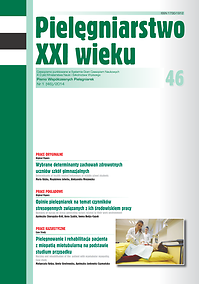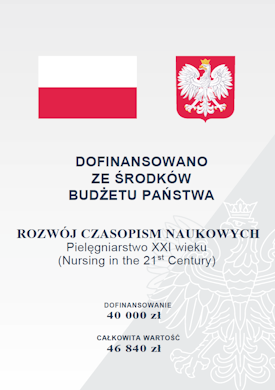Levels of work-related stress and workplace stressors in paramedics’ work
Keywords:
stress, work-related stress, stressors, paramedicAbstract
LEVELS OF WORK-RELATED STRESS AND WORKPLACE STRESSORS IN PARAMEDICS’ WORK
Introduction. The paramedic profession is associated with variability of stressful situations, especially: life-threatening events, suffering of casualties, illness and death, as well as interpersonal conflicts and work overload.
Aim. This paper aims at assessing the levels of experienced stress and identifying stressors among professionally active paramedics based on their gender, age, and work experience.
Methods. A survey was carried out between 25 April 2013 and 25 May 2013 in the Centre of Medical Rescue and Sanitary Transportation in Kielce, Świętokrzyskie Voivodeship among 98 paramedics. Perceived Stress Scale (PSS-10) was implemented to determine stress intensity in the first part of the survey. The second part of the instrument comprised a self-formulated questionnaire assessing the occurrence of work-related stressors and traumas.
Results. A low level of stress intensity is characteristic for 32.62% of respondents, an average level defines 34.69% of the surveyed, whereas 32.65% of the studied paramedics are described by high levels of work-related stress. Furthermore, the statistical analysis has proven that individuals under the age of 30 years and with work experience below 5 years are characterized by a low level of stress. The respondents between 31 and 45 years of age and work experience 6-15 years exhibit high levels of stress. The paramedics over 45 years of age with 15 years’ work experience show average levels of stress (p <0.05). In addition, more than half of the respondents consider the presence of children among victims as the most stressful factor in their work (52.04%). Other traumatic events include a direct threat to life (18.37%), gruesome views (14.29%), danger to co-workers’ life (11.22%).
Conclusions. These findings indicate that a majority of the surveyed paramedics are characterized by an average level of workrelated stress. One third of respondents have revealed high levels of stress. Furthermore, work experience and age are statistically significant as far as stress levels are concerned. Additionally, older people and these characterized by long years of service present themselves with higher levels of stress. Moreover, it was proven that there exists a close correlation between stress intensity and gender of surveyed paramedics.
References
1. Papiernik B, Holajn P, Żak-Jasińska K i wsp. Zespoł stresu pourazowego w pracy zawodowej ratownikow medycznych. Anestezjologia i Ratownictwo 2012; 6: 339-342.
2. Bartczak M, Bartczak M. Natężenie stresu i sposoby radzenia sobie ze stresem u ratownikow medycznych i studentow ratownictwa medycznego. Rocznik Naukowy Kujawsko-Pomorskiej Szkoły Wyższej w Bydgoszczy Nauki o Edukacji 2010; 5: 12-15
3. Heszen-Niejodek I. Teoria stresu psychologicznego i radzenia sobie. [w:] Strelau J, (red.) Psychologia. Podręcznik akademicki t. 3. Gdańsk: GWP; 2007.
4. Rożniatowski T, (red.) Mała encyklopedia medycyny, tom III P-Ż. Warszawa: PWN; 1991.
5. Augustynek A. Stres. [w:] Szewczuk W, (red.) Słownik psychologiczny, Szewczuk Warszawa: Wiedza Powszechna; 1985, s. 297.
6. Mietzel G. Wprowadzenie do psychologii, Gdańsk: GWP, Gdańsk 2008.
7. Bishop G. D. Psychologia zdrowia. Wrocław: Wydawnictwo ASTUM; 2000, s. 177-183.
8. Nowicki G, Goniewicz M, Jurkowska B i wsp. Stres w pracy, kontrola emocji a poziom lęku i depresji, przekonanie o własnej skuteczności u pracownikow systemu Państwowe Ratownictwo Medyczne. [w:] Goniewicz M, Nowicki G, (red) Ratownictwo medyczne – teraźniejszość i przyszłość. Lublin: Perfekra info; 2012: 107-120.
9. Antonovsky A. Rozwikłanie tajemnicy zdrowia. Jak radzić sobie ze stresem i nie zachorować. Warszawa: Wyd. Fundacji IPN; 1995.
10. Jonsson A, Segestan K. The meaning of traumatic events as described by nurses in ambulance service. Accid Emerg Nurs 2003; 11(3): 141-152.
11. Binczycka – Anholcer M, Lepiesz P. Stres na stanowisku pracy ratownika medycznego. Hygeia Public Health 2011; 46(4): 455-461.
12. Kowalczuk K, Krajewska – Kułak E, Jankowiak B i wsp. Zagrożenia zawodowe pielęgniarek, położnych i lekarzy w środowisku pracy. Probl Hig Epidemiol 2008; 89(2): 211-215.
13. Tomaszewski T. Wstęp do psychologii. Warszawa: PWN; 1967.
14. Cenin M. Trening psychologiczny. Analiza efektywności w trudnych sytuacjach zadaniowych. Wrocław: Wyd. Uniwersytetu Wrocławskiego; 1993.
15. Cafaro G, Sansoni J. Job satisfaction: a comparative study between public and private practice. Prof Interm 2010; 63(2): 67-76.
16. Wadsworth EJ, Chaplin KS, Smith AP. The work environment, stress and well-being. Occup Med 2010; 60(8): 635-639.
17. Juczyński Z, Ogińska-Bulik N. Narzędzia pomiaru stresu i radzenia sobie ze stresem. Warszawa: Pracownia Testow Psychologicznych; 2009.
18. Anczewska M, Świtaj P, Roszczyńska J. Wypalenie zawodowe. Post Psych Neurol 2005; 14: 67-68.
19. Stochmiłek J. Wokoł pojęcia „wypalenie zawodowe” w procesie pracy. Pedagogika pracy 2004: 44: 120-121.
20. Jabłkowski K, Borkowska A. Ocena nasilenia stresu w pracy a cechy zespołu wypalenia zawodowego u menadżerow. Med Pr 2005; 56: 439-440.
21. Hetherington A. Wsparcie psychologiczne w służbach ratowniczych. Gdańskie: Wydawnictwo Psychologiczne; 2004.
22. Ogłodek E, Araszkiewicz A. Przewlekły i pourazowy stres w zawodzie ratownika medycznego. Pol Merk Lek 2011; 31(182): 97-99
23. Ogińska-Bulik N, Kaflik-Pierog M. Stres zawodowy w służbach ratowniczych. Łodź: Wyd. Akademii Ekonomiczno-Humanistycznej w Łodzi; 2009:138.
24. Terelak JF. Wstęp, [w:] Terelak JF. Stres zawodowy charakterystyka psychologiczna wybranych zawodow stresowych. Bydgoszcz: WUKS; 2007.
25. Kowalczuk K, Jankowiak B, Krajewska-Kułak E i wsp. Ocena stopnia narażenia ratownikow medycznych na agresję w miejscu pracy, Annales Academiaemedi Caestetinensis Roczniki Pomorskiej Akademii Medycznej w Szczecinie 2009; 55: 70-75.
26. Ogłodek E. Nasilenie objawow stresu pourazowego u osob wykonujących zawod ratownika medycznego. Medycyna Środowiskowa 2011; 14: 54-58.
Downloads
Published
Issue
Section
License
Copyright (c) 2014 Barbara Ślusarska, Grzegorz Nowicki, Dorota Jędrzejewicz (Autor)

This work is licensed under a Creative Commons Attribution 4.0 International License.




